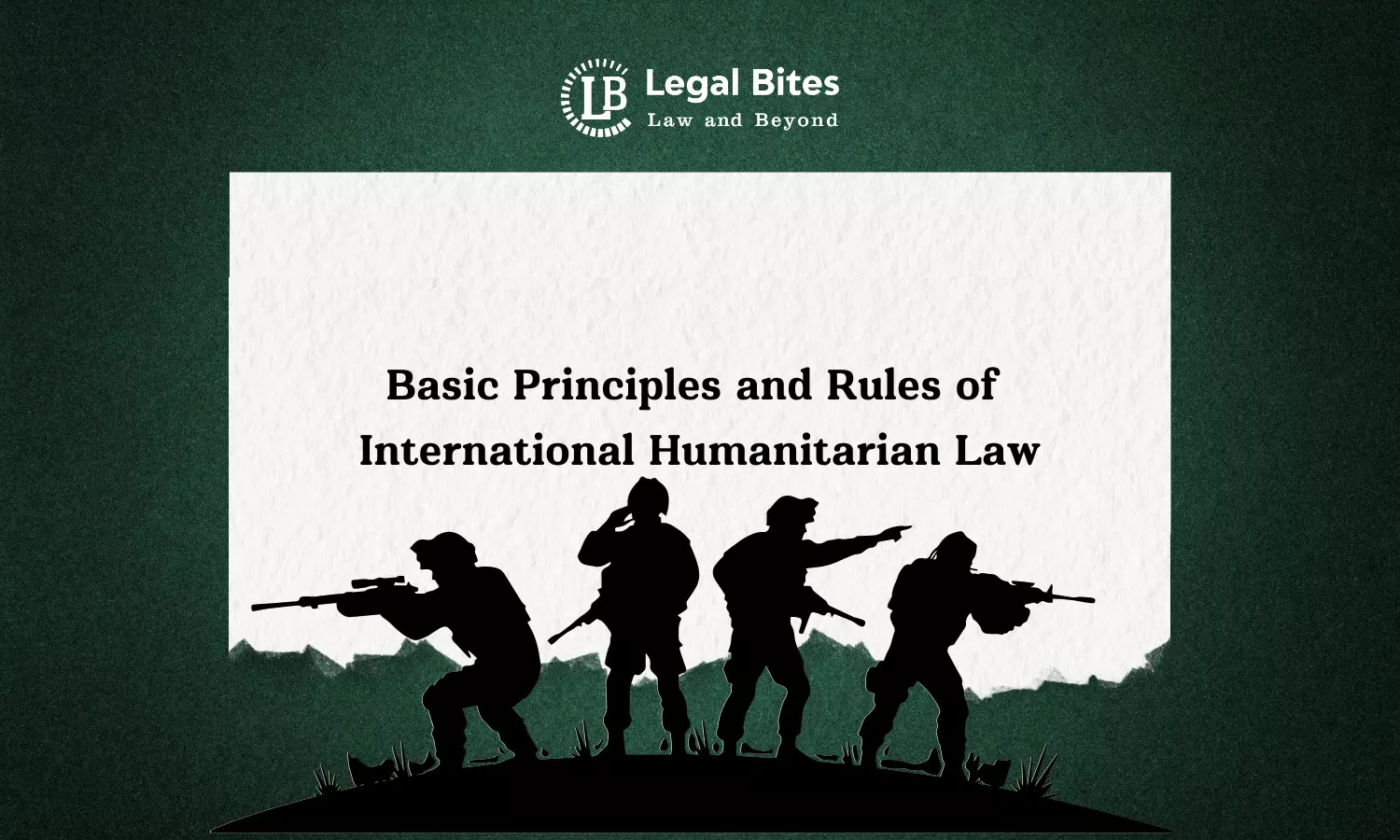Basic Principles and Rules of International Humanitarian Law
IHL is based on fundamental principles like humanity, distinction, and proportionality, aiming to reduce human suffering in war zones.

International Humanitarian Law (IHL), also known as the Law of Armed Conflict or Law of War, is a set of rules which seek to limit the effects of armed conflict for humanitarian reasons. It protects persons who are not or are no longer participating in hostilities and restricts the means and methods of warfare. IHL is rooted in the Geneva Conventions of 1949, their Additional Protocols, and customary international law. The primary goal of IHL is to balance military necessity with...
International Humanitarian Law (IHL), also known as the Law of Armed Conflict or Law of War, is a set of rules which seek to limit the effects of armed conflict for humanitarian reasons. It protects persons who are not or are no longer participating in hostilities and restricts the means and methods of warfare. IHL is rooted in the Geneva Conventions of 1949, their Additional Protocols, and customary international law. The primary goal of IHL is to balance military necessity with humanitarian considerations.
Sources of International Humanitarian Law
IHL derives its legal authority from two main sources:
1) Treaties and Conventions:
Treaties are the primary source of IHL. The four Geneva Conventions of 1949 and their Additional Protocols (1977, 2005) form the core, protecting wounded soldiers, prisoners of war, and civilians during armed conflict.
The Hague Conventions of 1899 and 1907 regulate means and methods of warfare. Other important treaties include the Chemical Weapons Convention, the Ottawa Treaty on landmines, and the Convention on Cluster Munitions.
2) Customary International Law:
Derived from the general and consistent practice of states followed out of a sense of legal obligation.
Fundamental Principles of IHL
IHL operates on several foundational principles, ensuring that hostilities do not lead to unnecessary suffering or unjustifiable destruction.
1) Principle of Distinction
- Parties to a conflict must distinguish between combatants and non-combatants (civilians), as well as between military objectives and civilian objects.
- Attacks may only be directed at combatants and military objectives.
- Indiscriminate attacks are prohibited (Additional Protocol I, Articles 48, 51, and 52).
2) Principle of Proportionality
Even when attacking a legitimate military target, the anticipated incidental loss of civilian life or damage must not be excessive to the concrete and direct military advantage anticipated (Additional Protocol I, Article 51(5)(b)).
3) Principle of Military Necessity
- Only those measures which are necessary to achieve a legitimate military objective are permitted.
- Acts not justified by military necessity, such as wanton destruction, are forbidden.
4) Principle of Humanity
- The use of violence that causes superfluous injury or unnecessary suffering is forbidden.
- Humane treatment of all persons not participating in hostilities is required (Common Article 3 of the Geneva Conventions).
5) Principle of Neutrality
- Non-participating states or humanitarian actors must not be targeted or involved in the conflict.
- Protects humanitarian organizations, such as the International Committee of the Red Cross (ICRC), in delivering aid.
Key Rules of International Humanitarian Law
IHL outlines specific rules to protect individuals and limit the means and methods of warfare. Some major rules include:
1) Protection of Civilians
- Civilians must not be the object of attack (Geneva Convention IV; Additional Protocol I).
- Starvation of civilians as a method of warfare is prohibited.
- Use of civilians as human shields is forbidden.
2) Treatment of the Wounded and Sick
- Wounded and sick, whether military or civilian, must be collected and cared for without discrimination (Geneva Convention I).
3) Protection of Prisoners of War (POWs)
- POWs must be treated humanely, with respect for their dignity (Geneva Convention III).
- They cannot be tortured or subjected to inhumane treatment.
4) Prohibited Means of Warfare
- Weapons that cause unnecessary suffering or have indiscriminate effects are banned.
- Prohibited weapons include biological and chemical weapons (1925 Geneva Protocol), blinding laser weapons (Protocol IV to the CCW), and anti-personnel mines (Ottawa Convention).
5) Protection of Cultural Property and the Environment
Attacks against cultural, religious, or historic sites are restricted (Hague Convention of 1954).
IHL also protects the natural environment from widespread, long-term, and severe damage (Additional Protocol I, Article 55).
Enforcement of International Humanitarian Law
The enforcement of IHL is crucial to ensure compliance by all parties in a conflict. Mechanisms include:
1) State Responsibility
- States are obliged to respect and ensure respect for IHL (Common Article 1 of the Geneva Conventions).
- Violations can lead to state responsibility under international law.
2) Individual Criminal Responsibility
- Individuals can be held accountable for war crimes before international tribunals (e.g., ICTY, ICTR, ICC).
- The Rome Statute of the International Criminal Court (1998) outlines war crimes subject to prosecution.
3) Role of the International Committee of the Red Cross (ICRC)
The ICRC monitors compliance, offers humanitarian assistance, and engages in confidential dialogue with parties to the conflict.
4) Domestic Implementation
States are required to incorporate IHL into their domestic legal frameworks and train armed forces accordingly.
Contemporary Challenges in IHL
1) Non-International Armed Conflicts (NIACs)
- The majority of modern conflicts are internal (e.g., civil wars, insurgencies).
- IHL provisions for NIACs are less detailed, leading to challenges in application and enforcement.
2) Terrorism and Non-State Actors
- The rise of non-state actors, such as terrorist organizations, complicates the application of IHL.
- Issues arise in distinguishing combatants and ensuring accountability.
3) Technological Warfare
- Use of drones, cyber warfare, and autonomous weapons systems raises new questions for IHL.
- Challenges include attribution of attacks and ensuring compliance with distinction and proportionality.
4) Urban Warfare
- Modern warfare increasingly takes place in densely populated areas, heightening risks to civilians.
- Compliance with the principles of distinction and proportionality becomes more complex.
Conclusion
International Humanitarian Law remains a vital part of the international legal order, providing a framework to reduce human suffering in armed conflict. Despite its limitations and the challenges posed by modern warfare, its fundamental principles remain relevant and essential. Ensuring respect for IHL requires concerted efforts by states, international organizations, civil society, and individuals. Strengthening its enforcement mechanisms and adapting its norms to evolving warfare realities will enhance its effectiveness and humanitarian impact.
References
[1] Summary of the Geneva Conventions of 1949 and Their Additional Protocols, Available Here
[2] Customary International Humanitarian Law, Available Here
[3] States' entitlement to take action to enforce international humanitarian law, Available Here
[4] Enforcement of International Humanitarian Law, Available Here

Karan Patel
Karan Patel is an alumnus of the prestigious Faculty of Law, Delhi University, with a specialization in Civil Law and Procedural Law. As a dedicated legal scholar, his work focuses on exploring the nuances of civil justice systems and procedural frameworks through in-depth research and writing.
